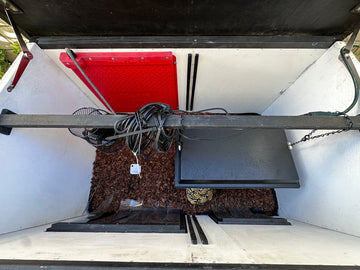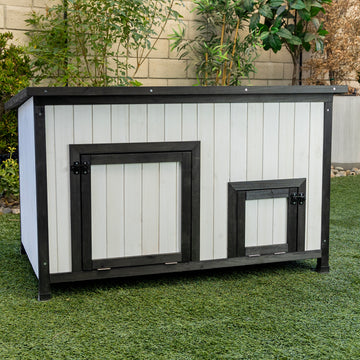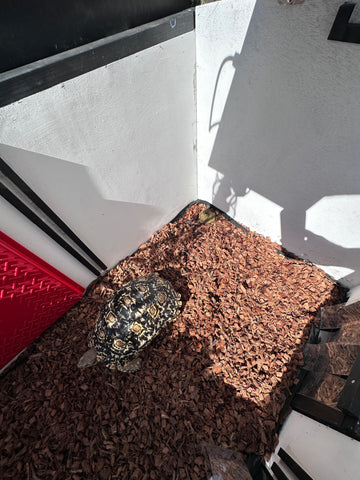When it comes to keeping your tortoise comfortable and healthy in an outdoor environment, proper heating is essential. As ectothermic animals, tortoises rely on external sources of heat to regulate their body temperature, making it crucial to provide them with a well-balanced heating setup inside their shelter. However, different types of heaters offer different benefits, and it’s important to choose the right combination that mimics their natural environment while providing comfort.
Below, we explore the different heating options available, their pros and cons, and how best to utilize them in a tortoise house like the Buddy Bungalow.
1. Radiant Heat Panels: Excellent Overhead Heat Source
Radiant heat panels are one of the most effective ways to provide overhead heat for tortoises. These panels emit infrared heat, which is similar to the warmth tortoises would receive from the sun in their natural habitat. Mounted on the ceiling or side of the shelter, radiant heat panels offer a gentle, even distribution of warmth, which is ideal for tortoises as they bask.
Key Benefits:
- Overhead Heating: Mimics the sun’s natural warmth, providing a more natural heating method for your tortoise.
- Safe for Prolonged Use: Radiant heat panels do not get excessively hot, making them a safe option for continuous use.
- Energy Efficient: These panels use less energy compared to traditional heaters, making them cost-effective.
2. Heat Pads: Better for Interior Side Mounting
Heat pads can be a good option for localized warmth, but they are better suited for being mounted on the interior sides of the tortoise house, rather than underneath. While they provide warmth, keeping a tortoise warm from underneath at all times is not natural, as they would typically cool down from the ground in nature. Heat pads mounted on the walls of the shelter can offer the tortoise a comfortable spot to rest when the external temperatures drop.
Key Benefits:
- Wall-Mounted Warmth: Mounted on the side of the bungalow, heat pads offer localized heat without overheating the tortoise.
- Convenient for Cooler Weather: Provides warmth when temperatures drop, allowing the tortoise to retreat to a cozy space.
Here's a link to the Kane Heat Mat!
3. The Importance of Nighttime Cool Down
It’s crucial for tortoises to experience a natural cool down at night. In the wild, tortoises have a distinct day and night temperature cycle, with cooler nights allowing their bodies to rest. Overheating a tortoise at night, especially with heat sources from below, can disrupt this natural rhythm. Providing overhead heat during the day and allowing temperatures to drop at night mimics this day-night dichotomy, ensuring your tortoise remains healthy.
4. Ceramic Heat Emitters (CHEs): Suitable with Careful Use
Ceramic Heat Emitters (CHEs) are another option for providing heat, but they must be used carefully. A CHE can be mounted in the tortoise house, but it’s essential that it is connected to a thermostat to ensure the temperature does not exceed 78°F on the top part of the tortoise’s shell. Prolonged exposure to temperatures above this level can be harmful.
Drawbacks of CHEs:
- Drying Effect: CHEs can dry out the surrounding air, which may negatively affect the tortoise's shell by causing dehydration.
- Thermostat Control Required: CHEs need to be carefully regulated to prevent overheating.
- Don't Forget: If you use a CHE, you'll need to put a safety cage around it.
5. Mini Oil Heaters: A Better Alternative for Stable Warmth
Mini oil heaters can be an excellent option for heating the tortoise house. Since oil heaters work by gradually heating oil within the unit, they don’t dry out the air like ceramic or coil heaters, preserving humidity levels that are crucial for the health of tortoises.
Key Benefits:
- Maintains Humidity: Unlike ceramic heaters, oil heaters maintain a more humid environment.
- Consistent Warmth: Provides gentle, consistent heat without overheating.
6. Avoid Dog House Heaters
Dog house heaters are not a suitable choice for tortoises. These heaters are often designed for larger animals and provide an intense level of heat that can quickly become overwhelming in the smaller, enclosed spaces of a tortoise house.
7. Creating the Perfect Heating Setup: Combining Sources
The ideal heating setup for a tortoise house involves using multiple heat sources to give your tortoise different temperature zones within their enclosure. Here’s a suggested setup:
- Heat Pad (Mounted on Wall): A heat pad mounted on one interior side of the shelter provides a warm area for your tortoise to retreat to when needed.
- Radiant Heat Panel: Install a radiant heat panel 4-6 inches above the tortoise on one side of the enclosure to mimic overhead sunlight.
- Low-Wattage Ceramic Heat Emitter: Place a low-wattage CHE on the opposite side of the enclosure, controlled by a thermostat to maintain a maximum of 78°F on the tortoise's shell.
This setup creates multiple spaces within the tortoise house where the tortoise can regulate its body temperature throughout the day and night, choosing the right level of warmth as needed.
Conclusion
Proper heating is essential for the well-being of your tortoise, but it’s important to choose the right combination of heat sources that mimics the natural environment. Radiant heat panels provide an excellent source of overhead warmth, heat pads are best for localized side-mounting, and careful use of CHEs and oil heaters can offer a well-balanced heating system. By creating different zones in the tortoise house, you give your pet the ability to regulate its temperature naturally and safely.












